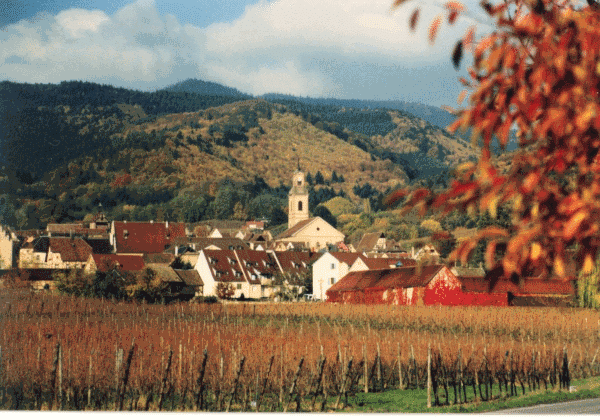For many years my husband and I lived in the Stuttgart area of Germany – less than two hours from the French border and Alsace. Whenever we had the chance, we’d hop in the car and head in that direction—for a day, a weekend, or even longer. We loved the food, the scenery, the ambience —and the wine. We’d often stop for a degustation (tasting). Many wineries display degustation signs, beckoning you to stop for a sip or more.
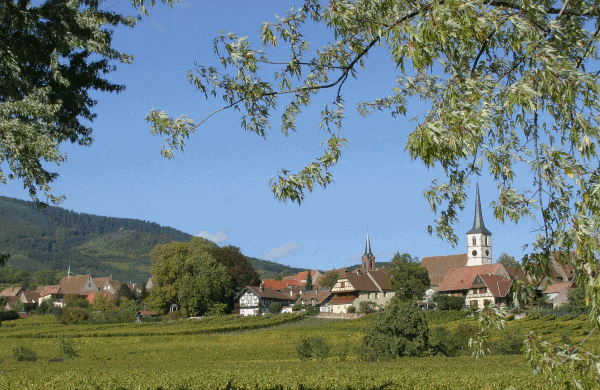
Alsace is an ideal place to mix travel with wine tasting. The Alsace Wine Route extends for 105 miles from Marlenheim in the north near Strasbourg to Thann in the south, almost at the Swiss border. It twists through a rolling landscape of vineyards stretched along the foothills of the Vosges Mountains, from one quaint and charming village to another. Castles perch on top many a mountain. You could tour the area in a day, but that would be a pity. Better to drive through the region at a leisurely pace and linger.
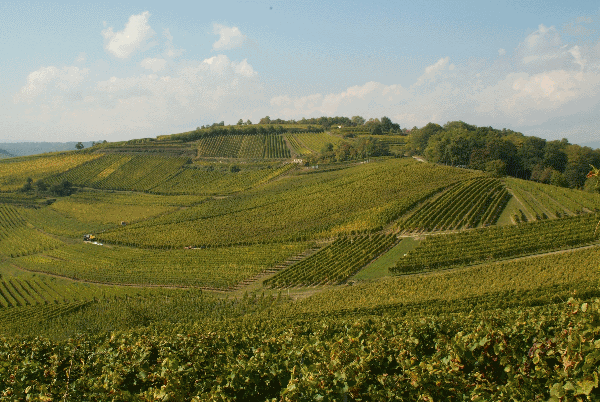
In warm weather, tasting tables are often set up in the pretty courtyards of half-timbered vintner houses. Wooden wine barrels, old wine presses, and hanging geraniums decorate the courtyards and create the perfect tasting atmosphere. Keep in mind that tasters are expected to buy at least a few bottles.
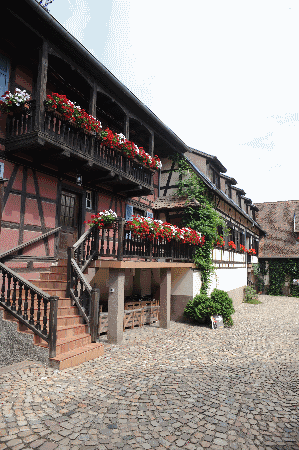
One of our favorite stops was the town of Mittelbergheim at the family winery, Domaine Armand Gilg. Nelly Gilg told us that 20 years ago or more there were many Alsatian vintners producing mediocre wines but that global warming has made it easier for everyone to produce quality wines. “Grapes look for sun and warmth. They ripen earlier now. We’ve gained a month.” She explained that the vines now begin to flower in early June with harvest normally 100 days later, meaning that grapes are usually ready for picking in mid-September. “In my grandfather’s day, the vines didn’t flower until late June and harvest was in October.” Alsace wines are made primarily from aromatic grape varieties and are mainly white, both dry and sweet, although the majority is dry.
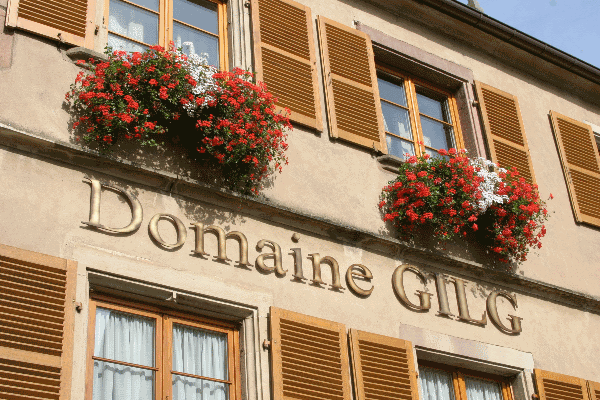
Another one of our favorite wineries is Louis Sipp in the charming town of Ribeauvillé. “Our wines are different than the other white wines of France, such as Burgundy and Bordeaux,” explains Simone Sipp who runs the winery with her husband Louis. “Our grape varieties are fresher and fruitier and we make our wine in a different way. Our grapes are all cultivated by hand. Very little wine in Alsace is aged in oak.” Since 2005, all the Sipp wines are organic, she said.
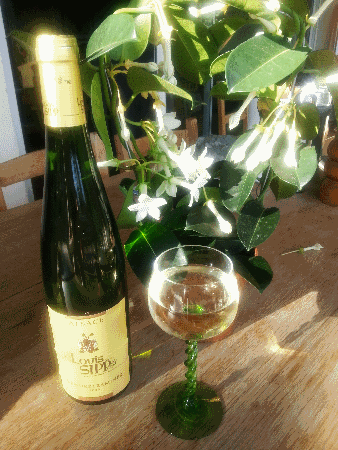
Alsatian wines are generally named after the grape variety from which they are produced, the main ones being Riesling, Pinot Blanc, Sylvaner, Muscat, Pinot Gris, Pinot Noir, and Gewürztraminer. The dry Rieslings are some of the most noted in the world and Gewürztraminer, also renowned, is characterized as “intense, complex and offering an explosion of exotic fruits and spices.” It’s more expensive than most of the others because the grapes are tiny and fragile and yield less juice. Edelzwicker is another Alsatian blend made from several varieties. The Alsatian sparkling wine is Crémant d’Alsace, produced using the Champagne wine-making method and often from several grape varieties.
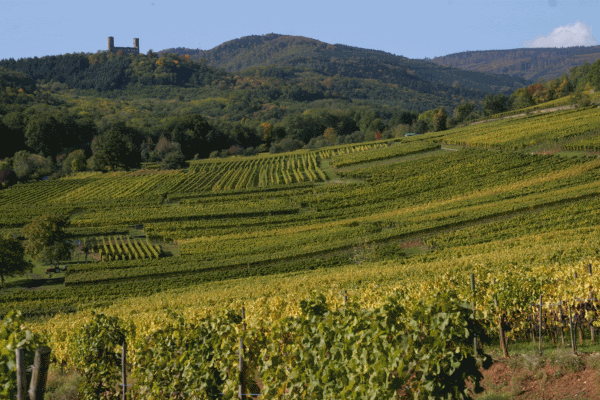
For historical reasons, Alsatian wines have a strong German influence. During the past 100 years, Alsace went from France to Germany, back to France, back to Germany, and finally to France again. Some say the region has a German character with a French soul. Its two most important grapes, Riesling and Gewürtztraminer, are German. The Pinot Noir grape produces the red wine of the region which is pale in color and usually classified as rosé. “Pinot Noir is becoming more important in Alsace thanks to improved growing methods and production techniques,” said Melanie Pfister who took over running the family wine estate, Domaine Pfister in Dahlenheim. The 32-year-old vintner said more and more women are now involved in Alsatian wine production.
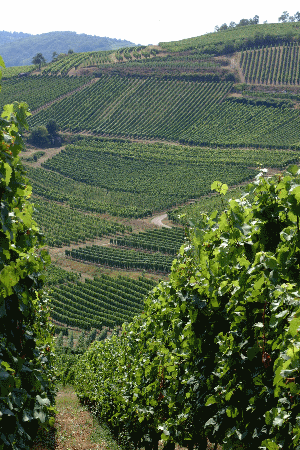
The climate and soil in Alsace are ideal for producing fine wines. To the east beyond the RhineRiver the massive Black Forest protects its towns and vineyards from bleak east winds. To the west the Vosges Mountains provide a barrier to the Atlantic storms which sweep across northern France. Along with Champagne, it’s the most northerly wine-producing region in France and is one of the country’s sunniest wine regions with a warm, dry, semi-continental climate. Its vineyards are situated on the sub-Vosgian foothills at an altitude between 200 and 400 meters (660 – 1,320 feet) taking advantage of maximum sun exposure.
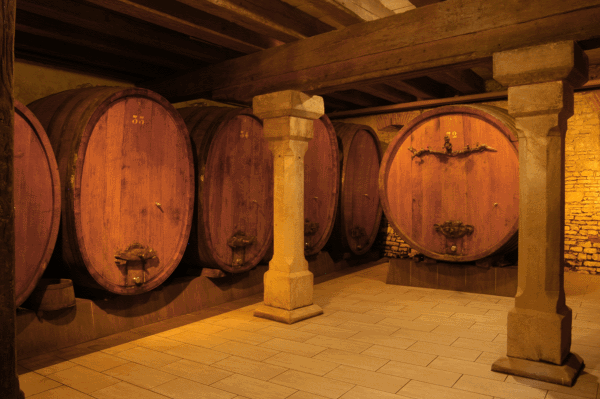
The region has a complicated geological history giving it a variety of soils. At Turckheim and Wintzenheim, for example, there are granite terraces side by side with calcareous strips. At Riquewihr, sandstone and schist lie next to limestone. Growers carefully match each wine variety to the parcel of land whose soil is best suited to it. Wines are labeled Appellation d’Origine Contrôlée (certificate of origin) or Alsace Grand Cru Contrôlée. The latter is used to designate a wine from a specific vineyard site with lower than average yields and strict vineyard cultivation rules. There is a third label for the sparkling wine: Crémant d’Alsace Contrôlée.
The wines, which are bottled in elongated green bottles, should be served cool but not chilled (46-50 degrees F.) and shouldn’t be stored in the refrigerator as this could spoil the bouquet. They are best drunk young, from six months to five years, and are served in Alsace in special glasses – tulip shaped with a rounded bowl and long, colored stem (usually green). Sipp pointed out that a good quality wine can rest for three to four years, giving it time to develop.
Alsatian wines marry well with food and can enhance red or white meat, as well as fish and seafood. Muscat is a perfect aperitif. Gewürztraminer is recommended as an accompaniment to foie gras, as well as ethnic dishes such as Chinese, Vietnamese, Japanese and Mexican. Riesling, a “gastronomic wine par excellence,” is ideal with fish, shellfish, seafood, white meat, and that Alsatian specialty, choucroute (sauerkraut).
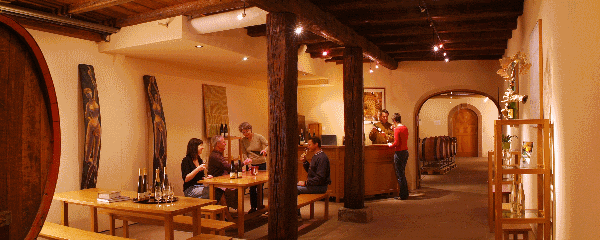
A drive along the wine route can be enriched with a stop for a hike in the vineyards. Signposted trails plunge deep into the vine-covered slopes, offering wonderful photo opps, as well as the opportunity to see vine cultivation up close. There are 26 different trails in the region, and each has informative signs explaining the work of the winegrower and the character of each grape variety.
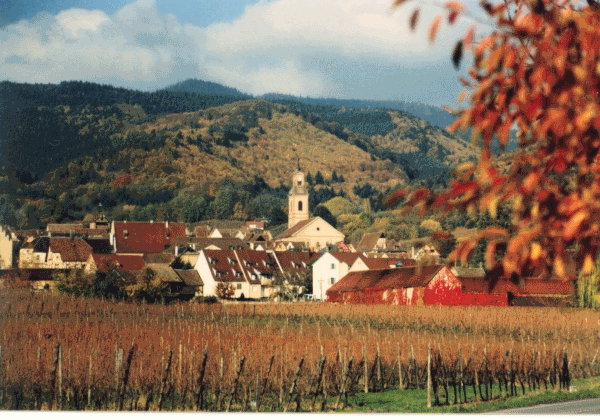
From April to October, many winegrowing villages have festivals and wine fairs.
“Where there is wine there is joie de vivre. Wine generates happiness and conviviality.” says vintner Jean Sipp, a cousin of Simone Sipp who also has a winery in the town of Ribeauvillé. We found plenty of joie de vivre, not to mention delicious wines, along the Route du Vin.
*For more information on travel in France, there’s no better tool than a DK Eyewitness Travel Guide
The area code for France is 33
Where to Drink the Wines:
Domaine Pfister- The Pfister family has been established wine makers for century in the Alsace region. This vineyard offers tastings in their exclusive tasting room from 9-12 and 2-6:30 Monday-Saturday. 53 rue principale, Dahlenhiem; 33 (0) 3 88 50 66 32 www.domaine-pfister.com
Domaine Armand Gilg – Visitors are welcome to a tasting and tour of the grounds. 2 rue Rotland, Mittelbergheim. This vineyard is associated with the hotel by the same name; 33 (0) 3 88 08 92 76; www.domaine-gilg.com
Louis Sipp- This vineyard dates back to the First World War but only recently began practicing organic farming. Tasting are offered. 5 Grand Rue, Ribeauvillé ; 33 (0) 3 89 73 60 01 ; www.sipp.com
Where to Stay:
Domaine Jean Sipp- This hotel and wine vineyard is located in a former seignorial residence dating from 1416. 60 rue de la Fraternité, Ribeauvillé ; 33 (0) 3 89 73 60 02 ; http://www.jean-sipp.com/en/
Domaine du Neufeld, Oberhaslach – Our favorite place to stay, a “ferme auberge,” a horse farm in the Vosges foothills just 30 minutes from Strasbourg. Simple but comfortable and tastefully decorated rooms, some with shared bath facilities. Evening meals are jolly events at a large table with other guests. A delightful, warm and welcoming address with plenty of joie de vivre. Relais Equestre, Oberhaslach 67280; 33 03 88 50 91 48; www.leneufeld.fr
Hotel de la Tour – Located in the heart of Ribeauville, this hotel is a great place to stay while seeing the many sights of the area. 1 rue de la Mairie, Ribeauville 68150; 33 03 89 73 72 73; www.hotel-la-tour.com
Hotel Le Menestrel – Situated within a vineyard this hotel offers breathtaking views and a large selection of Alsatian wines. 27 av G. De Gaulle, Ribeauville 68150; 33 03 89 73 80 52; http://www.hotel-la-tour.com/en/hotel-le-menestrel.aspx
Where to Eat:
Auberge de l’Ill – Called a “monument to gastronomy” and with three Michelin stars, this is the ultimate. Chef Marc Haeberlin is the fourth generation of his family to head up this exalted temple of haute cuisine. After dining in the posh dining room, you can retreat to the lovely garden on the edge of the River Ill for coffee. It doesn’t get much better than this. 2 Rue de Collonges au Mont d’Or, Illhaeusern 68970; 33 03 89 71 89 00; www.auberge-de-l-ill.com
La Table du Gourmet, Riquewihr – Chef Jean Luc Brendel has two restaurants in this medieval town, a brasserie, d’Brendelstub, and La Table du Gourmet which is located in a 16th century building that was once used by wine growers. Guest rooms also available. 5 rue de la 1ere Armee, Riquewihr 68340; 33 03 89 86 54 55; www.jlbrendel.com
Hotel-Restaurant Gilg – This charming restaurant in a building dating from 1614 is cozy and classy. After or before lunch, visit the Gilg wine shop. Rooms are also available. 1 Route Du Vin, Mittelbergheim; 33 03 88 08 91 37. www.hotel-gilg.com
Auberge du Parc Carola – Gastronomic restaurant on the Route du Vin. 48 route de Bergheim, Ribeauville ; 33 03 89 86 05 75 ; www.auberge-parc-carola.com

